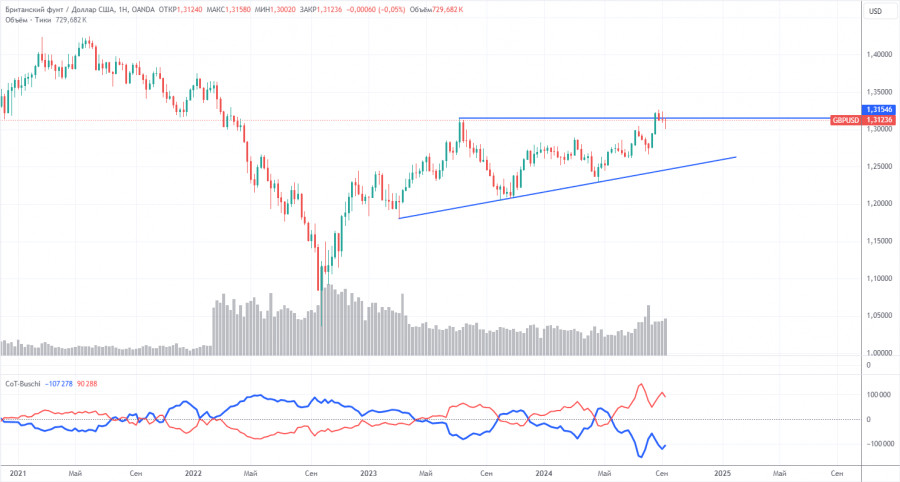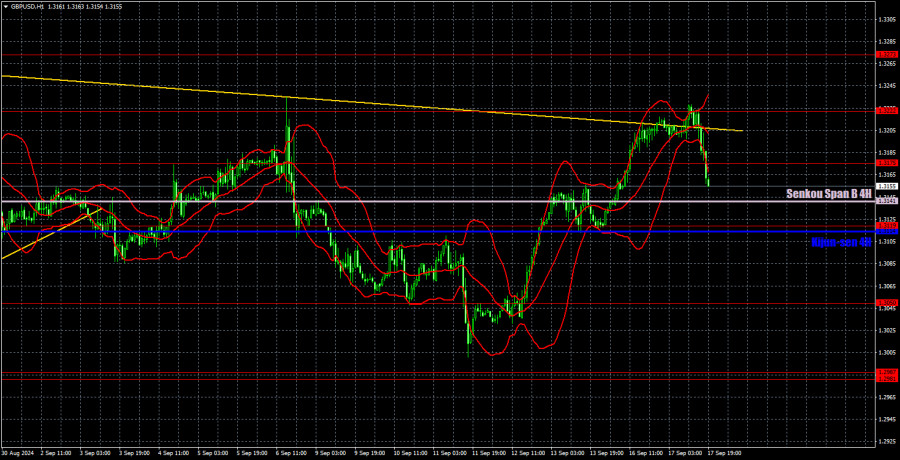

The GBP/USD pair showed a fairly decent decline on Tuesday. Let's break down this movement. The fall began during the U.S. trading session. During the European session, the pound, as usual, was rising, even though there were no reasons or grounds for it. After bouncing off the 1.3222 level, it declined by 60-70 pips. One could even say that U.S. data triggered the dollar's rise if it weren't for one detail: the euro didn't react to the same reports at all. This leads to another paradoxical situation where the market moves wherever it pleases, with no logic or consistency in the current movements of major currency pairs. Before the Federal Reserve meeting, the market simply swung back and forth. The pound rose for three days and then started to fall. There were no reasons for either the rise or the fall. According to the technical picture, the pound should have resumed its decline around the 1.3119 level.
Therefore, we adhere to our previous point of view: in the medium term, the pound sterling should only be declining, and there is no logic in the pound's movements at this time. The market seems utterly uninterested in what reports are being released, what the data shows, or what the Bank of England plans to do. From a purely technical point of view, a fall back to the 1.3000 level, where the current growth spurt began, can be expected. However, the trend line has been broken, and both Ichimoku indicator lines have been surpassed. It gives the impression that market makers deliberately throw the pair from side to side to trigger Stop Loss orders.
However, on the 5-minute time frame yesterday, two decent sell signals were formed around the 1.3222 level, which duplicated each other. These could have been leveraged for a short position. Subsequently, the price broke through the 1.3175 level and returned to the Senkou Span B line, offering an opportunity to secure profits.

The COT reports for the British pound show that the sentiment of commercial traders has been subject to frequent changes in recent years. The red and blue lines, representing the net positions of commercial and non-commercial traders, constantly intersect and are mainly close to the zero mark. We also see that the last downward trend occurred when the red line was below the zero mark. Therefore, a downturn could be expected around the level of 1.3154, but this assumption will need regular confirmation over time.
According to the latest report on the British pound, the non-commercial group closed 18,700 buy contracts and 900 sell contracts. Thus, the net position of non-commercial traders decreased by 17,800 contracts over the week, but overall, it continues to grow.
The fundamental background still does not provide any grounds for long-term purchases of the pound sterling, and the currency has a real chance to resume the global downtrend. However, an ascending trend line formed in the weekly time frame. Therefore, a long-term decline in the pound should not be expected unless the price breaches this trend line. Despite almost everything, the pound continues to rise. Even when COT reports show that major players are selling the pound, it continues to increase.

In the hourly time frame, GBP/USD continues to correct, but this correction could end at any moment. We still do not see the market rushing to sell the pair and buy the U.S. dollar. Thus, the British currency's baseless and illogical upward trend may resume (or may have already resumed). The trend line has been broken, and the Ichimoku indicator lines have been surpassed and now serve as support for buyers. Yesterday, the dollar strengthened; today, it might fall again. Or it could continue to decline. The market is in complete chaos.
For September 18, we highlight the following key levels: 1.2605-1.2620, 1.2691-1.2701, 1.2796-1.2816, 1.2863, 1.2981-1.2987, 1.3050, 1.3119, 1.3175, 1.3222, 1.3273, 1.3367. The Senkou Span B lines (1.3141) and Kijun-sen (1.3114) can also serve as signal sources. Setting the Stop Loss to break even when the price moves in the intended direction by 20 pips is recommended. The Ichimoku indicator lines may shift during the day, which should be considered when determining trading signals.
No significant events are scheduled for Wednesday in the UK, while in the U.S., reports on new home sales and building permits will be released. However, traders will again focus on the upcoming Fed meeting scheduled for the evening.
Support and resistance levels: Thick red lines near which the trend may end. They are not sources of trading signals.
Kijun-sen and Senkou Span B lines: These Ichimoku indicator lines, transferred from the 4-hour timeframe to the hourly chart, are strong lines.
Extreme levels: Thin red lines from which the price previously bounced. These provide trading signals.
Yellow lines: Trend lines, trend channels, and other technical patterns.
Indicator 1 on COT charts: The net position size for each category of traders.

SZYBKIE LINKI